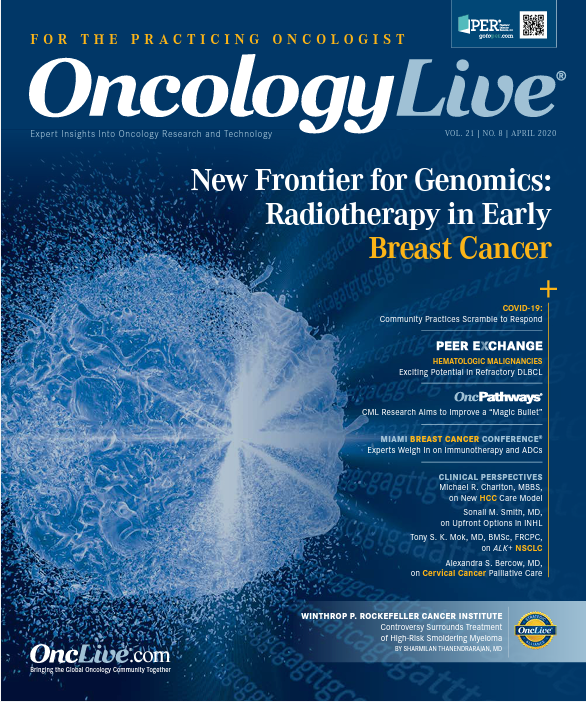Application of Neratinib in Breast Cancer Broadens
Adam M. Brufsky, MD, PhD, FACP, discusses the use of neratinib and the importance of expanding the treatment portfolio in HER2-positive metastatic breast cancer.
Adam M. Brufsky, MD, PhD, FACP, medical director of the MageeWomen's Cancer Program at the University of Pittsburgh Medical Center Hillman Cancer Center

Adam M. Brufsky, MD, PhD, FACP
The recent approval of neratinib (Nerlynx) in combination with capecitabine (Xeloda) for patients with late-stage, heavily pretreated HER2-positive breast cancer expanded the therapy’s established role in this disease setting.
Neratinib was initially approved in July 2017 for the extended adjuvant treatment of adults with early-stage HER2-overexpressed/amplified breast cancer, to follow adjuvant trastuzumab (Herceptin)-based therapy.1
The latest approval is based on efficacy results from the phase III NALA trial (NCT01808573), which showed that treatment with the doublet therapy not only significantly improved progression-free survival (PFS) but also trended toward an overall survival benefit among those who received the combination. At 12 months, the PFS rate was 29% (95% CI, 23%-35%) with neratinib and capecitabine versus 15% (95% CI, 10%-20%) with lapatinib (Tykerb) and capecitabine.1
In an interview with OncLive®, Adam M. Brufsky, MD, PhD, FACP, codirector of the Comprehensive Breast Cancer Center and associate chief of the Division of Hematology/Oncology at the University of Pittsburgh Medical Center Hillman Cancer Center in Pennsylvania discussed neratinib and the importance of expanding the treatment portfolio in HER2-positive metastatic breast cancer.
OncLive: Could you discuss the pivotal efficacy data that led to the approval?
Brufsky: There were a few interesting things about this trial. Some are subtle and some are not, but the bottom line is that the NALA trial showed efficacy. The trial’s primary end point was progression-free survival, and it met that end point in an unusual way. This is where it gets a little bit complicated: The survival curve separated late, after about 6 months. I think most likely they separated later [in the trial] because there were probably fewer progressions of brain metastases.
The progression-free survival was 8.8 months In the neratinib and capecitabine arm and 6.6 months in the lapatinib and capecitabine arm. The overall survival benefit was about a month and a half, on average, and it was not statistically significant. What was interesting, though, was that the duration of response almost doubled. What was also interesting was that, unlike the HER2CLIMB study [NCT02614794] of tucatinib—which is a similar agent but does not induce diarrhea [as frequently as neratinib]—we did not require an MRI [magnetic resonance imaging] at baseline. Only about 20% of the patients in our study had brain metastases, but we did not really know that, so we looked to see who required symptomatic intervention for brain metastases to estimate who had brain benefit.
As it turns out, about 30% in the lapatinib and capecitabine arm required a symptomatic intervention for brain metastases versus about 22% in the neratinib and capecitabine arm. That is an improvement in absolute terms of about 8% and of about 25% to 30% in relevant terms. In trying to understand the data, I think neratinib, [which is] an irreversible binder to HER2, will cross the blood-brain barrier, get onto the brain metastasis, and stick. It will not come off. [In contrast], lapatinib is a reversible binder and could come back off because it is reversible. To me, that probably explains a lot of the benefit of neratinib in these patients.
What is the agent’s mechanism of action?
Neratinib blocks the HER2 receptors on the cell surface that dimerize with another protein called HER3. When that happens, the internal part of the receptor called the tyrosine kinase domain is activated. A lot of these small molecules like neratinib and lapatinib bind to the HER2 tyrosine kinase domain and block it from being activated. Neratinib is an irreversible binder that prevents the HER2 signal from being transmitted to the rest of the cell.
How does the agent fit into the current treatment paradigm?
In HER2-postive disease, we have fam-trastuzumab deruxtecan-nxki [Enhertu], which was approved in January. Trastuzumab deruxtecan is very powerful and seems to work pretty well, but we are not sure if it gets into the brain. [However], neratinib does get into the brain.
There is a competitor to neratinib that will likely get FDA approval—tucatinib. With the [ongoing] pandemic, we are unsure when that is going to happen; we thought it would probably come over the summer. Tucatinib has the same affinity for the HER2 receptor as neratinib, but the difference between the 2 is that tucatinib does not bind to the epidermal growth factor receptor, and that is why there is a lot less diarrhea. We have a lot of ways now to manage the diarrhea, and with dose escalation of the neratinib starting at 150 or 160 mg a day and using antidiarrhea pills like loperamide when escalating the dose, we actually reduce the incidence of severe diarrhea to single digits.
Another drug that has been tested is margetuximab, which is a reengineered HER2 receptor developed to have more of an immune response. The theory is that if there is a more of an immune response to the receptor, it will synergize with trastuzumab to potentially kill more cells, and it will do so by better interacting with a receptor on the surface of natural killer cells.
Margetuximab was tested in the phase III SOPHIA trial [NCT02492711]. Although there was a progression-free survival benefit with margetuximab, there was not an overall survival benefit. The trial needed to reach both end points to be declared successful, so right now, margetuximab is in a bit of limbo because we are not quite sure whether [those data will] be enough for the FDA to approve it. It is an interesting drug, and we have a lot of trials that are going to be done with it now going forward, especially in the early setting including neoadjuvant therapy.
What does the approval of neratinib mean for this disease setting?
I think the overall summary of this entire field is that we did not have a lot of options for the second or third line and beyond for patients with HER2-positive metastatic breast cancer. Right now, the point estimate is a little under 5 years survival. In the CLEOPATRA trial [NCT00567190] of frontline pertuzumab [Perjeta], trastuzumab, and docetaxel for HER2-positive metastatic breast cancer, the median overall survival was 56.5 months, but interestingly enough, a third of the women were still alive 8 years later. What we want to do now is make that number 50% or 60% at this 8-year mark, and we can start to do that. Then I think you will start to see the natural history of this disease really make a change. I think we have done that already, but these agents are going to push it even further. That is why the approval of neratinib is so exciting.
Nerlynx [prescribing information]. Los Angeles, CA: Puma Biotechnology, Inc; 2020. www.accessdata. fda.gov/drugsatfda_docs/label/2020/208051s005s006lbl.pdf. Accessed March 19, 2020.




